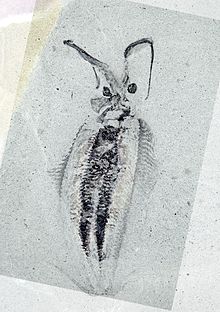| Nectocaris Temporal range:
| |
|---|---|

| |
| Specimen ROM 60079 | |
| Scientific classification | |
| Domain: | Eukaryota |
| Kingdom: | Animalia |
| Family: | †Nectocarididae |
| Genus: | †Nectocaris Conway Morris, 1976 |
| Species: | †N. pteryx
|
| Binomial name | |
| †Nectocaris pteryx Conway Morris, 1976
| |
Nectocaris is a genus of squid-like animal of controversial affinities known from the Cambrian period. The initial fossils were described from the Burgess Shale of Canada. Other similar remains possibly referrable to the genus are known from the Emu Bay Shale of Australia and Chengjiang Biota of China.
Nectocaris was a free-swimming, predatory or scavenging organism. This lifestyle is reflected in its binomial name: Nectocaris means "swimming shrimp" (from the Ancient Greek νηκτόν, nekton, meaning "swimmer" and καρίς, karis, "shrimp"). Two morphs are known: a small morph, about an inch long, and a large morph, anatomically identical but around four times longer.[1]
Nectocaridids have controversial affinities. Some authors have suggested that they represent the earliest known cephalopods. However, their morphology is strongly dissimilar to confirmed early cephalopods, and thus their affinities to cephalopods and even to molluscs more broadly are rejected by most authors.[2][3] Their affinities to any animal group beyond Bilateria are uncertain, though they have been suggested to be members of Lophotrochozoa.[3]
The closely related Ordovician taxon Nectocotis is a second genus, closely resembling Nectocaris, but suggested to have had an internal skeletal element.[4]
- ^ Smith, M.R. (2013). "Nectocaridid ecology, diversity and affinity: Early origin of a cephalopod-like body plan". Paleobiology. 39 (2): 291–321. Bibcode:2013Pbio...39..297S. doi:10.1666/12029. S2CID 85744624.
- ^ Pohle, Alexander; Kröger, Björn; Warnock, Rachel C. M.; King, Andy H.; Evans, David H.; Aubrechtová, Martina; Cichowolski, Marcela; Fang, Xiang; Klug, Christian (December 2022). "Early cephalopod evolution clarified through Bayesian phylogenetic inference". BMC Biology. 20 (1): 88. doi:10.1186/s12915-022-01284-5. ISSN 1741-7007. PMC 9008929. PMID 35421982.
- ^ a b Cite error: The named reference
:1was invoked but never defined (see the help page). - ^ Smith, Martin R. (2019). "An Ordovician nectocaridid hints at an endocochleate origin of Cephalopoda" (PDF). Journal of Paleontology. 94: 64–69. doi:10.1017/jpa.2019.57. S2CID 201208912.